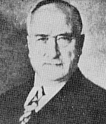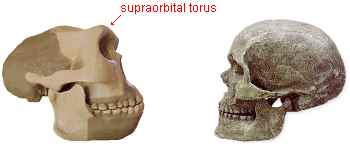By 1.8 million years ago, one of the early transitional human
populations had evolved into a new, fully human
species in Africa. Most paleoanthropologists refer to them as Homo
erectus . However,
some researchers now split them into two species--Homo ergaster
and Homo erectus.
The H.ergaster fossils were earlier, dating 1.8-1.5 million years ago,
and have been found mostly in East Africa. The
H.erectus discoveries date 1.2-0.4 million years ago and have been found
widespread in Africa, Asia, and Europe. The approach taken in this
tutorial is to treat these two possibly distinct, but closely related, species
as one--Homo erectus.
Homo erectus were very successful in developing cultural technologies that allowed them to adapt to changing environmental conditions (climatic glaciations and interglaciary periods). They were true pioneers in developing human culture and in moving out of Africa to populate tropical and subtropical environmental zones elsewhere in the Old World, possibly as early as 1.8 million years ago. One location foundrecently, is Israel. Surprisingly, however, they remained largely unchanged anatomically until about 600,000 years ago. After that time, there were progressive evolutionary developments in features of the head that were characteristic of modern humans. By about half a million years ago, some Homo erectus were able to move into the cooler temperate environmental zones of Asia and Europe for the first time. This migration was made possible by greater intelligence and new cultural technologies.
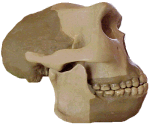 Homo erectus |
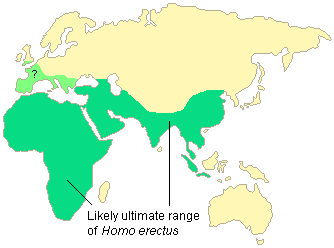 | |||||||||||||||
Evolutionary Relationships
The earliest Homo erectus apparently were contemporaries of the late Homo habilis in East Africa for several hundred thousand years. This suggests that the immediate ancestor of Homo erectus was an early Homo habilis or even another yet to be discovered species of early humans.
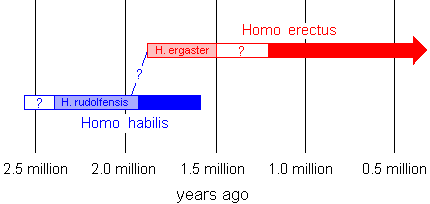
History of Discovery
|
|
| Eugene Dubois (1858-1940) |
In the late 19th century, our knowledge of human fossil ancestors did not go back beyond that of the Neandertals in Europe less than 100,000 years ago. There was no inkling of our much earlier ancestors in Africa. A few scientists speculated that the most ancient humans would be found some place in East Asia. One of the people who strongly held this view was a Dutch anatomist and medical doctor named Eugene Dubois. Late in 1887, he went to the Dutch East Indies (now Indonesia) as a military doctor. This job allowed him enough spare time to pursue his major interest, the search for early human fossils. He first explored the big island of Sumatra. Excavating in several caves, he found a hominid jaw fragment in 1890. However, this was not convincing evidence of early human ancestry. He then moved on to Java. During excavations in the eastern part of that island in 1891-1892, he recovered a Homo erectus brain case and femur (upper leg bone). Since he had discovered an unknown species, he took the liberty of naming it in an 1894 publication. He called it Pithecanthropus erectus (literally "ape man who stands erect"). He returned to Holland with his fossils in 1895 and proclaimed them to be from our earliest ancestor. Unfortunately for Dubois, most of the leading paleontologists of his day were not convinced.
Dubois' claims for his Java Homo erectus finds were not widely accepted until the 1930's, when the German/Dutch paleontologist Gustav von Koenigswald made similar discoveries in the Dutch East Indies. By that time, there had also been even more convincing discoveries of Homo erectus in China. Dubois stubbornly refused to accept any of these fossils as being from the same species as his "Java Man" specimens.
Dating the Java Homo erectus fossils has been difficult. In the past, it was generally accepted that most of these bones are 700,000-500,000 years old based roughly on the presumed date for the geological strata in which they were found. In 1994, however, radiometric dating of sand particles attached to two of the fossils indicated that they were actually 1.8 and 1.6 million years old. Critics have suggested that the true age may be nearer to 1.5 million years. If any of these very early dates are correct, it implies that some Homo erectus left Africa soon after they evolved from Homo habilis.
In 1911, a revolution in China overthrew the last emperor of the Manchu Dynasty and set up a Western-style republic under the American-educated Dr. Sun Yat-Sen. In imitation of western nations, the Geological Survey of China was established in 1917 with a Swedish geologist named J. Gunnar Anderson as its advisor. Among the many tasks of the Survey was a search for the source of "dragon bones." These were fossil bones that ended up in Chinese apothecary shops as medicines. They are still popularly used by older men in China as sexual stimulants.
 |
| Davidson
Black (1884-1934) |
In 1921, Gunnar Anderson discovered that one of the important sources of "dragon bones" in North China was an abandoned limestone quarry near the village of Zhoukoudian. This was only a day's drive over rough dirt roads from Beijing. In 1927, a fossil was found in this ancient cave that turned out to be a Homo erectus molar tooth. It was examined by Davidson Black, a Canadian anatomy professor at Peking Union Medical College. He identified the tooth as being from an earlier species of human. He named it Sinanthropus pekinensis (literally "Chinese man from Peking or Beijing"). This discovery sparked 10 years of intense excavations by Anderson, Black, and others (especially Pei Wenshong after 1929 and Franz Weidenreich in the 1930's). The bones of 40 individual Homo erectus were eventually found at Zhoukoudian.
 |
| "Peking Man" |
The Homo erectus skeletal evidence at Zhoukoudian is especially important because it is from a population of men, women, and children rather than just a single individual. There was considerable sexual dimorphism and individual variability. The human remains were associated with large quantities of animal bones that apparently were mostly food refuse. A few of these bones were burned in a way that suggests cooking to some researchers. In addition, more than 100,000 stone, bone, antler, and horn tools were excavated. The cave was intermittently occupied by late Homo erectus for nearly a quarter of a million years, beginning about 460,000 years ago.
With the exception of two teeth, all of the Homo erectus bones from Zhoukoudian were lost in the chaos of late 1941, when the Japanese Army invaded the Beijing area. There have been a number of intriguing guesses about what happened to the bones. The last time they were accounted for was when they were turned over to a U.S. Marine detachment, placed in wooden foot-lockers, and taken 140 miles from Beijing to Camp Holcomb. They were to be transported by ship to the U.S. for safety on an American freighter named the President Harrison. However, after the U.S. entered the war on December 7, 1941, Japanese forces quickly seized Camp Holcomb. At that point in time, the Zhoukoudian fossils disappeared and have never reappeared. In 1949, the Peoples Republic of China established a $100,000 reward for their return. Unfortunately, it has not been claimed. The only surviving bones were the two teeth that had not been turned over to the Marines in 1941.
The loss to science of the Zhoukoudian bones was not as great as it may initially seem. Earlier, they had been measured, photographed, and excellent casts of them had been successfully sent to the U.S. In addition, other Homo erectus skeletal material has been excavated in China since the mid 1960's. Most notably are the finds that were recovered from Lantian County, Shensi Province. These fossils from several Chinese sites date to 1,150,000-650,000 years ago. In contrast, the Zhoukoudian cave site was occupied from about 460,000 to 230,000 years ago.
 |
|
"Turkana Boy" |
In 1960, Louis and Mary Leakey found a 1.25 million year old Homo erectus partial cranium at Olduvai Gorge. Subsequently, more Homo erectus fossils were discovered there and at other sites in East, South, and Northwest Africa. The oldest known Homo erectus date to at least 1.8 million years ago in East Africa. This strongly suggests that Homo erectus originated there. In 1984, Richard Leakey's team working at Nariokotome on the western side of Lake Turkana found a nearly complete Homo erectus skeleton of a 12 year old boy dating to 1.6 million years ago. It was named the "Turkana Boy." The significance of this discovery will be discussed below.
Two surprisingly early Homo erectus skulls were found during the 1990's on the fringes of Eastern Europe at Dmanisi in the Republic of Georgia. They date to 1.7 million years ago and look very much like the earliest Homo erectus from Africa--i.e., those that have been classified by some researchers as Homo ergaster. This discovery lends credence to the 1.8 and 1.6 million year old dates for Homo erectus from Java and to an early rather than late Homo erectus expansion out of Africa.
Also during the 1990's, Homo erectus-like bones were discovered from several other sites in Western Europe and Northwestern Africa that date to 800,000-400,000 years ago (especially at Atapuerca, Boxgrove, and Salé). It has been difficult to assign these late fossils to specific species due to the fact that they have characteristics of both Homo erectus and archaic Homo sapiens. Some paleoanthropologists consider them to be late transitional Homo erectus. Others suggest that they are from subsequent species (Homo antecessor and Homo heidelbergensis) that preceded modern humans. This difference of species assignment is not particularly important and it does not detract from our growing understanding of the broad evolutionary trends. It is a result of our evolving conceptualization of the past as more data becomes available. It also partly reflects the fact that the picture of human evolution looks somewhat different in different regions of the Old World. It is now becoming clear that human evolution was not as straight forward as it once was commonly thought.
|
Important Homo erectus Sites | ||||||||||||||||||||||||||||||||||||||||||||||||||||||||||
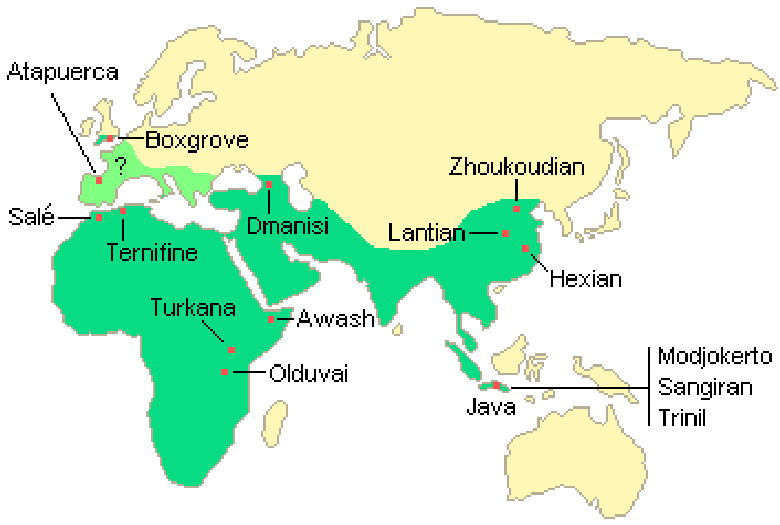 |
| |||||||||||||||||||||||||||||||||||||||||||||||||||||||||
| * | The Salé and Boxgrove fossils are considered by some researchers to be Homo heidelbergensis instead of Homo erectus. Likewise, the Atapuerca fossils have been labeled Homo antecessor by those who take a splitter approach to classification. |
